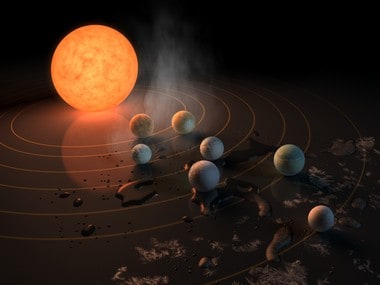The seven Earth-size planets of **TRAPPIST-1** are all mostly made of rock, with some having the potential to hold far more water than Earth, 250 times more than the oceans on our home planet, says a study that offers the best-yet picture of what these **planets** are made of. [caption id=“attachment_3997383” align=“alignleft” width=“380”]  TRAPPIST -1 has seven planets in its exo-system. NASA[/caption] The form that water would take on TRAPPIST-1 planets would depend on the amount of heat they receive from their star, which is a mere nine percent as massive as our Sun. Planets closest to the star are more likely to host water in the form of atmospheric vapour, while those farther away may have water frozen on their surfaces as ice. TRAPPIST-1e is the rockiest planet of them all but still is believed to have the potential to host some liquid water, said the study published in the journal Astronomy and Astrophysics. The findings are based on data from NASA’s Spitzer and Kepler space telescopes. “We now know more about TRAPPIST-1 than any other planetary system apart from our own,” said study co-author Sean Carey, Manager of the Spitzer Science Center at the Infrared Processing and Analysis Center (IPAC) at California Institute of Technology (Caltech) in Pasadena, California. “The improved densities in our study dramatically refine our understanding of the nature of these mysterious worlds,” Carey said. TRAPPIST-1 is named for the Transiting Planets and Planetesimals Small Telescope (TRAPPIST) in Chile, which discovered two of the seven TRAPPIST planets we know of today, announced in February 2016. NASA’s Spitzer Space Telescope, in collaboration with ground-based telescopes, confirmed these planets and uncovered the other five in the system in February 2017. In the new study, scientists led by Simon Grimm at the University of Bern in Switzerland created computer models to better simulate the planets based on all available information. “Densities, while important clues to the planets’ compositions, do not say anything about habitability. However, our study is an important step forward as we continue to explore whether these planets could support life,” said co-author Brice-Olivier Demory from the University of Bern. The study showed that TRAPPIST-1b, the innermost planet, is likely to have a rocky core, surrounded by an atmosphere much thicker than Earth’s. TRAPPIST-1c also likely has a rocky interior, but with a thinner atmosphere than planet b. TRAPPIST-1d is the lightest of the planets - about 30 percent the mass of Earth, the study said. Scientists were surprised that TRAPPIST-1e is the only planet in the system slightly denser than Earth, suggesting it may have a denser iron core than our home planet. In terms of size, density and the amount of radiation it receives from its star, this is the most similar planet to Earth. TRAPPIST-1f, g, and h are far enough from the host star that water could be frozen as ice across these surfaces. If they have thin atmospheres, they would be unlikely to contain the heavy molecules of Earth, such as carbon dioxide, the study said.
The form that water would take on TRAPPIST-1 planets would depend on the amount of heat they receive from their star.
Advertisement
End of Article


)
)
)
)
)
)
)
)
)



